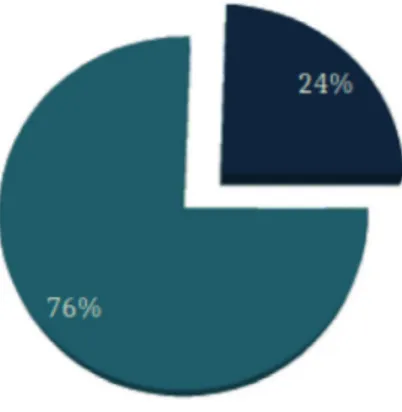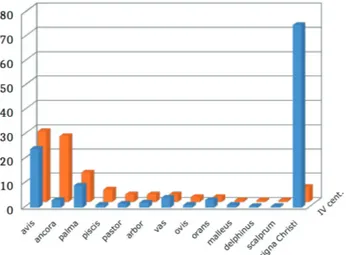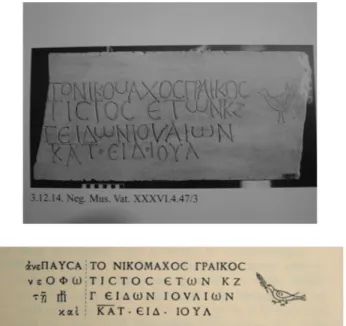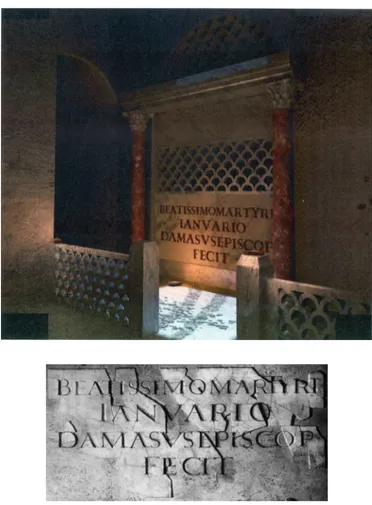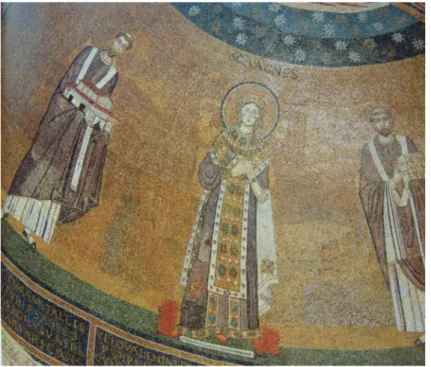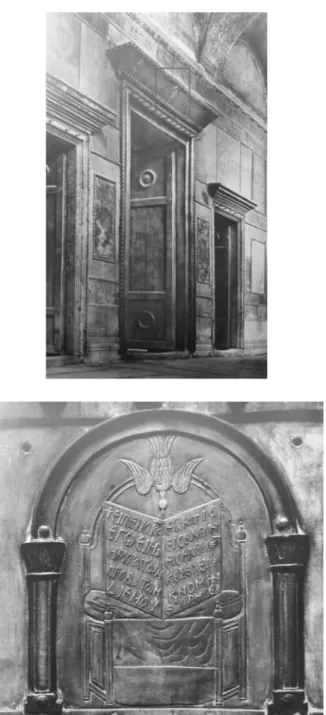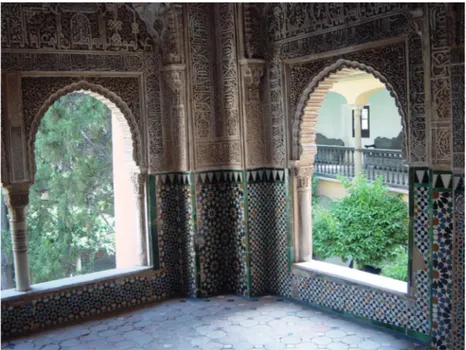Convegni
Studi umanistici – Antichistica
Digital and Traditional
Epigraphy in Context
Proceedings of the EAGLE 2016
International Conference
edited by
Silvia Orlandi, Raffaella Santucci, Francesco Mambrini, Pietro Maria Liuzzo
Digital and Traditional
Epigraphy in Context
Proceedings of the EAGLE 2016
International Conference
edited by
Silvia Orlandi, Raffaella Santucci
Francesco Mambrini, Pietro Maria Liuzzo
Studi umanistici
Serie Antichistica
Digital and Traditional
Epigraphy in Context
Proceedings of the EAGLE 2016
International Conference
edited by
Silvia Orlandi, Raffaella Santucci
Francesco Mambrini, Pietro Maria Liuzzo
2017
Studi umanistici
Copyright © 2017
Sapienza Università Editrice
Piazzale Aldo Moro 5 – 00185 Roma www.editricesapienza.it
Iscrizione Registro Operatori Comunicazione n. 11420 ISBN 978-88-9377-021-7
DOI 10.13133/978-88-9377-021-7
Quest’opera è distribuita con licenza Creative Commons 3.0 diffusa in modalità open access.
Distribuita su piattaforma digitale da:
Centro interdipartimentale di ricerca e servizi
Settore Publishing Digitale
This volume is dedicated to the memory of
Silvio Panciera
without whom EAGLE would have never existed.
Table of content
Preface xi
Keynotes
EAGLE: Past, Present, and Future
Silvio Panciera, Silvia Orlandi 1
Where Eagles Dare
Charlotte Roueché 11
Putting ancient inscriptions in the limelight
Mary Beard 17
Tradition and progress. The Roman World in the Digital Age - seen through Inscriptions
Werner Eck 19
Infrastructures for Digital Research: New opportunities and challenges
Lorna Hughes 37
part i - Digital editions of inscriptions: methods, problem, approaches
1. AXON. A Selection of Greek Historical Inscriptions. A Database for Research and Teaching
Digital and Traditional Epigraphy in Context viii
2. The digital edition of the archaic Latin inscriptions (7th-5th century B.C.)
Giulia Sarullo, Giovanna Rocca, Marta Muscariello 67
3. I.Sicily: an epidoc corpus for ancient Sicily
Jonathan Prag, James Chartrand, James Cummings 83
4. Towards the Publication of ICI Siracusa: General Data and Previews
Mariarita Sgarlata 97
5. EDB 2.0. How EAGLE improved the Epigraphic Database Bari
Anita Rocco 115
6. Visual features of Inscriptions. An issue for EDB (and EAGLE)
Antonio Felle 131
7. Working with Text and Images: The Graffiti of Herculaneum
Rebecca Benefiel, Holly Sypniewski, Sara Sprenkle 145
part ii - Collaborating in digital epigraphy
8. The EAGLE Data Aggregator: Data Quality Monitoring Rebecca Benefiel, Holly Sypniewski, Sara Sprenkle, Andrea Mannocci,
Vittore Casarosa, Paolo Manghi, Franco Zoppi 161
9. The EAGLE portal
Claudio Prandoni 173
10. Mapping Databases to EpiDoc
Pietro Maria Liuzzo 187
11. Trismegistos Places, a geographical index for all Latin inscriptions
Herbert Verreth 201
12. Augmenting the workspace of epigraphists: An interaction design study
Angelos Barmpoutis, Eleni Bozia 209
13. TIGLIO. Translations and Images of Greek and Latin Inscriptions Online
Pietro Maria Liuzzo, Bridget Almas, Ryan Baumann, Marie-Claire, Beaulieu, Hugh Cayless, James Cowey, Finlay Mc Court, Joshua Sosin 221
Table of Content ix
14. A Virtual Research Environment to Document and Analyze Non-alphabetic Writing Systems
Katja Diederichs, Sven Gronemeyer, Christian Prager, Elisabeth Wagner, Franziska Diehr, Brodhun Maximilian, Nikolai Grube 233 15. Integration of Multimedia Collections and Tools for Interaction
with Digital Content. The case study of the Archaia Kypriaki Grammateia Digital Corpus
Uros Damnjanovic, Valentina Vassallo, Sorin Hermon 247 part iii - Users, epigraphy and the social web
16. Free Reproduction of Cultural Heritage for Research Purposes: Regulatory Aspects and New Prospects for Project EAGLE
Mirco Modolo 263
17. Digital enhancement of the “Paolo Orsi” museum: a Google Street View 360 pilot project tour
Elisa Bonacini 273
18. Latin Epigraphy for the Visually Impaired. New Technologies to Favour Universal Accessibility
Francesca Licordari 287
19. Teaching (Digital) Epigraphy
Marion Lamé, Federico Ponchio, Ivan Radman-Livaja,
Bruce Robertson 301
20. Epigraphy in Italian High Schools
Enrico Zuddas 317
part iv - Digital approaches to cross disciplinary studies of inscriptions
21. Romans 1 by 1. Documenting a population database for the Roman world
Rada Varga 333
22. Towards a Universal Facebook of the Ancient World
Yanne Broux 343
23. Epigraphy and Onomastics in the Hesperia Database
Digital and Traditional Epigraphy in Context x
24. The Power of Images at Aphrodisias: How Digital Resources can Transform our assessment of Palaeography
Abigail Graham 367
25. Deixis and Frames of Reference in Dedicatory Epigrams
Flavia Licciardello 391
part v - Panels
1. Assessing the Role of Digital Libraries of Squeezes in Epigraphic Studies
Eleni Bozia 405
2. EAGLE Featured Panel
Vittore Casarosa 411
3. Epigraphic Echoes in Epigrams
Marion Lamé 415
List of Posters Presented 418
6. Visual features of inscriptions.
An issue for EDB (and EAGLE)
Antonio Enrico Felle*
Abstract
In these last years the amount of digital images of inscriptions increased very quickly: we do not need accurate textual descriptions of the so-called
anagly-pha, because we can directly see them. But we have to build a search-by-image,
using photos and drawings but also tagging them with standardized – and shared - labels.
The issue of the “illustrated inscriptions” brings us to consider more broadly all the visual features of inscriptions, that were conceived as objects to see, not only to read.
Keywords: Early Christian Epigraphy, Byzantine Epigraphy, Middle Ages Epigraphy, Images, Symbols, Signs, Paleography, Stonecutters’ workshops
6.1. “Illustrated inscriptions” by the Christians of Rome
In 2012, during a conference in Rome about Late Antique plates deco-rated with engravings, I presented a paper about the potentially very useful contribute that the Epigraphic Database Bari (EDB) could offer to study and to interpret the notion and the use of images (signs, sym-bols, figures and so on) by the Christians of Rome in Late Antiquity, by analyzing the inscriptions stored in the database (Felle 2013).
Then, the first datum was that a quarter of these epigraphs dis-plays images or generical non-alphabetical signs (Felle 2013, p. 101) (fig. 1).
After storing in EDB other 10000 inscriptions, since 2012 to the pre-sent day, the percentage of figured inscriptions is still the same: then,
Digital and Traditional Epigraphy in Context 132
I think that we are able to consider this datum enough sure; so we are able to partially correct the common idea that using images in written monuments is a recurrent, typical and characteristic feature of almost all the Early Christian inscriptions.
The second datum defined by the 2012 survey was the proportional decreasing of the use of different kind of images from the first decades of the IV century (the age of Constantine), when a huge and pervasive use of the so-called signa Christi – first of all the Chi-Rho monogram, with all its variations – prevails on all the other signs and figures (Felle 2013, 101-102).
Carlo Carletti explained this phenomenon as the result of a will to display explicit signs of a religious identity, such the Chi-Rho mono-gram is (Carletti 2008, 68-72; Felle 2007, 365-366). But we have to underline that the phenomenon is not exclusive of Christian patrons. We observe more and more recurrent similar “signs of identity” also among inscriptions commissioned by Jews, not only in Rome but also in other contexts in Late Antiquity world where they were (Felle 2007, passim; Felle).
Going back to the inscriptions by Christians, the use of signa Christi in form of monograms strongly reduces the use of other christologi-cal signs or figures, as for instance the anchor: this one, very recurrent during all III century, disappears completely and very quickly, already in the very first decades of IV century (Felle 2012, 103) (fig. 2).
6. Visual features of inscriptions 133
Since its conception, EDB recorded the presence and the different kinds of various signa Christi, both by a checkbox and in the text field, with standardized descriptions, with the aim to easily retrieve them in the database and to get valuable results from structured queries about their recurrence.
The results of the 2012 study were mainly of quantitative nature; today, by the existing large repositories of images in EDB – as like in general in EAGLE and in other similar projects – we can improve the qualitative analysis of this and other features of Late Antique inscrip-tions.
First of all, we have to say that in EDB we faced huge difficulties about the treatment of images other than signa Christi, or generally other non-alphabetical signs, or also captions related to figures on the slabs, and so on. Indeed, at the moment we are still not able to au-tomatically obtain by EDB a structured index of the repertoire of the images. As in other epigraphic databases, in EDB they are recorded directly reporting their descriptions as like they are in printed editions (sometimes very old, as the first volumes of ICVR, for instance); there, in absence of pictures, the so-called anaglypha are concisely described by simplified and repetitive clichées to suggest the depicted subjects to the readers (fig. 3) or by brief descriptions in Latin in transcriptions or also in the commentaries (fig. 4).
Fig. 6.2. Use of different images in inscriptions by Christians of Rome between III and IV
Digital and Traditional Epigraphy in Context 134
Fig. 6.4. Rome, coemeterium Maius, now in the Vatican Museums. Photo (from Iscrizioni
1997, sch. 3.8.3) and edition in ICVR, VIII 22407.
Fig. 6.3. Rome, coemeterium Hippolyti, now in the Vatican Museums. Photo (from Iscrizioni
6. Visual features of inscriptions 135
Often, these descriptions are different although indicating the same subjects: in the ICVR, the reason of this disomogeneity is not only the longue durée of the realization of the corpus (seventy years, since 1922 to 1992, when the last published volume, the tenth, appeared) but also a refined textual variatio. Surely it can be appreciated in printed edi-tions but, for the aim of our digital archives, it produces real difficul-ties.
Some examples: in EDB different verbal descriptions about the some subject are recorded, such as avis uvam pascitur (e.g. ICVR, III 8114a, b, c, e), or avis uvas pascitur (ICVR, III 8004b); or also avis race-mum carpens (ICVR, IX 24020), avis racerace-mum carpit (ICVR V, 14157), avis racemum pascitur (ICVR, V 15194), avis racemum rostro carpit (ICVR, IV 10934): it is not easy to perceive some difference). However, this vari-atio prevents right results in retrieving data in our database.
Moreover, recording in EDB descriptions with different words for the same illustrated subject, such as “avis, racemus” (EDB 19827: ICVR, III 9311, see fig. 5.a) or “avis cum racemo” (EDB 24933: ICVR, III 8044, see fig. 5.b) we are not able to retrieve all the occurrences of this same subject, because they are recorded (both in ICVR and in EDB) in dif-ferent ways.
This ambiguity prevents to retrieve all the occurrences of the same illustrated subjects and then they adulterate the result of our queries: I think that we have to correct as soon as possible this ambiguity, in order to establish an unique way to describe the anaglypha.
One can say that the present ease to obtain and to use digital pic-tures of the inscriptions overtakes this issue: surely that’s true. But, I do not entirely agree with this point of view.
a b
Digital and Traditional Epigraphy in Context 136
In these last years – also with the kind help by the Photographic Ar-chive of Papal Commission of Sacred Archaeology ( http://www.archeo-logiasacra.net/pcas-web/) – the amount of images available in EDB in-creased very quickly: this is surely an advantage in respect to the situation of only three years ago. At the present day and more over in the future, we no longer need accurate textual descriptions of the anaglypha: we can directly see them. But, the possibility to easily view a photo or a drawing of an inscription does not solve the issues related to search and to retrieve inscriptions bearing given kinds of image, or specific signs, and so on.
The relative high occurrence of images in Christian inscriptions drives EDB team to try to build a search-by-image, using photos and draw-ings, but also tagging them with standardized labels. A “high definition” analysis of non-verbal language of the inscriptions by Christians of Rome in Late Antiquity surely needs photos, drawings, and so on, but mostly needs a logical, structured, hierarchically ordered taxonomy of all non textual elements defined by controlled, firm and shared vocabulary: a thesaurus imaginum1, that can be a suitable tool also to trail the activity of
different stonecutters’ workshops that served – in the case of EDB inscrip-tions – the various users of the Roman Christian catacombs.
6.2. Visual features of the ‘written monuments’
The issue of the “illustrated inscriptions” brings us to consider more broadly the visual features of inscriptions overall. The ancient epigraphs are conceived not only as texts to be read (very few people were able to do it) but also – and, maybe, firstly – as objects to be seen. I think that we have to realize this perspective – common in Christian epigraphy studies after all – to understand the communication power of this communicative medium. Indeed, the topic has been assumed as main theme of the last International Congress of Greek and Latin Epigraphy in Berlin in 2012 (Öffentlichkeit 2014); very recently, a just published volume collects various essays about this same topic just about the Late Antique, Medieval (both Christian and Islamic) world,
1 Surely the experiences of other projects can be useful to this aim: I think for
instance to the solutions presented during the VIth EAGLE International Event in Bari by the lecture offered by Rebecca Benefiel and Holly Sypniewski about the Ancient Graffiti of Herculaneum project: see now Benefiel-Sypniewsky, 2016)
6. Visual features of inscriptions 137
where this notion of the inscriptions as ‘written monuments’ stands out with strong evidence (see Eastmond 2015).
In our projects – we have to admit it – the notion that inscriptions are essentially texts is still largely prevailing: but now we can – consequently, we must – to increase our capability to represent, to record and so to in-vestigate also other, visual features of inscriptions.
6.2.1. Positioning
First of all, I think to the positioning of the epigraphs in the contexts for which they were created. About EDB, we already presented in the EA-GLE Conference in Paris in 2014 a first attempt to record and to describe the exact positioning of the inscriptions still found in their original spot, by sharing data with the Domitilla-Projekt (by the Österreichische Aka-demie der Wissenschaften and the Deutsches Archäologisches Institut) focused to the frescoes of the catacomb of Domitilla along via Ardeatina, the largest one in Rome suburb (Felle - Zimmermann 2014). The positive collaboration between our two projects continued: now we are able to offer to EDB users to view on the updated map of the catacomb of Domit-illa the distribution of the inscriptions still in situ in the four levels of the subterranean cemetery: one can use them as reliable documents to (re-) consider the history of the complex, to confirm or to deny the ideas about chronology of its excavation and of its frescoes and about the using of the different zones of the catacomb.
6.2.2. Materials and shape
Materials and shape of the written objects communicate im-mediately, to all, before the inscribed texts. Because now we can do it, we have to display to the users of our projects the real communicative power of the inscriptions, that assume much more meaningfulness when we can see them than when we can read their only texts in a library. By pictures and 3D rendering of the places where the epigraphs were arranged we should be able also to provide virtual images of inscriptions – also lost or incom-plete – conceived to be seen and read exactly there. An effective example can be the dedication by pope Damasus (366-384) to the martyr Ianuarius in the catacomb of Praetextatus on the via Appia (fig. 6).
The bishop of Rome reaches his aim to capture the gaze also of illiterate faithfuls by placing a very large slab of white marble over the tomb of the martyr, well-lighted by a skylight made on purpose, in strong contrast to the darkness of the neighbouring galleries of the subterranean cemetery.
Digital and Traditional Epigraphy in Context 138
Also the text is aimed at the same goal: the dedication is brief and simple, inscribed using a special writing, very carefully carved by us-ing a font specially elaborated for Damasus’ inscriptions by the fashion-able designer Furius Dionysius Philocalus. The contrast with the com-mon inscriptions in the catacombs, often made by reused marble pieces or bricks, and very often (not always!) written with rough letters, is impressive.
The bishop’s intervention is more meaningfully revealed to all by the visual features of his inscriptions than by their only (metrical or not) texts.
Fig. 6.6. Rome, catacomb of Praetextatus. Damasus’ dedicatory inscription (ICVR, V
6. Visual features of inscriptions 139
Fig. 6.7. Thessaloniki, city walls. Inscriptions in the masonry of a tower near Eptapyrgion
(photo: A. E. Felle).
Fig. 6.8. Rome, basilica of the martyr Agnes on the via Nomentana. Apse mosaic with
Digital and Traditional Epigraphy in Context 140
This notion about written monuments is more and more diffused in Western Early Middle Ages and also in Byzantium: one has no need to read, to perceive the actual and effective messages displayed by inscriptions placed within the fabric of the walls of Byzantine cit-ies, such as Constantinople or Thessaloniki (fig. 7).
There, the inscriptions are not carved in marble slabs or stone blocks, but they are realized with the same materials of the walls: simple bricks, but disposed to obtain letters and signs and symbols, visible also from afar. The inscriptions explain the walls; the walls speak its raisons d’être by the inscriptions, that are in different cas-es rich of abbreviations, closed to the reading but open to the sight: writing appears intrinsically significant. In my opinion, this notion is clearly demonstrated by the unnecessary captions in the icons and in the images of martyrs (fig. 8), where – on closer view – the inscrip-tions are completely useless, if we continue to consider them only as texts to be read.
6.2.3. Relationship with the context
Indeed – more over in Late Antiquity and Middle Ages – readabil-ity of the texts is not the main property of inscriptions: rather, the main condition appears their relationship with their contexts. An incisive example can be offered by the Christian inscriptions bearing biblical quotations (cfr. Felle 2006): in the middle of the bronze plating of the marble lintel over the Great Door of the Royal Gates of the Haghia So-phia in Constantinople, an empty throne is occupied by an open codex, according to the words by Kähler, “the only extant plastic composition dating from the founding period of the church” (Kähler 1967, pp. 29-30; 32 taff. 22; 62) (fig. 9).
On the open codex is inscribed a focused – but barely readable – quotation from John 10, verses 7 and 9, where Jesus indicates himself as the gate:
John 10.7: Εἶπεν οὖν πάλιν ὁ ᾿Ιησοῦς, ᾿Αμὴν ἀμὴν λέγω ὑμῖν ὅτι ἐγώ
εἰμι ἡ θύρα τῶν προβάτων. (Therefore Jesus said again, ‘Very truly I tell you, I am the gate for the sheep);
6. Visual features of inscriptions 141 John 10, 9: ἐγώ εἰμι ἡ θύρα· δι› ἐμοῦ ἐάν τις εἰσέλθῃ σωθήσεται καὶ
εἰσελεύσεται καὶ ἐξελεύσεται καὶ νομὴν εὑρήσει ( 9I am the gate; who-ever enters through me will be saved.They will come in and go out, and find pasture).
This the text of the inscription (Felle 2006, n. 505):
((crux)) εἶπεν ὁ κ(ύριο)ς | ἐγώ εἰμι | ἡ θύρα τῶν | προβάτων· | δι᾿ ἐμοῦ || ἐάν τις | εἰσέλθῃ | εἰσελεύσετ(αι) | κ(αὶ) ἐξελεύσετ(αι) | κ(αὶ) νομὴν | εὑρήσει.
The archeological context and the mirate positioning make tangi-ble, concrete, the sacred words; and the real presence (not necessarily the readability) of the sacred words give proper and strong sense to their material support and to entire context, the Royal Gates of the Great Church of Constantinoples (Felle 2015, p. 320 and passim). 6.2.4. Writing
Scarce or null readability does not imply low quality of the ap-pearance of writing: rather, the writing appears intrinsecally mean-ingful such as visual element of the equipment of a simple or rich funerary monument or of a cultual building. Then, we have to face the issue of the description of the writing not only from the neces-sary point of view of paleography (we are still waiting for a shared and controlled vocabulary of paleographical definitions), but also in order to perceive and to understand its non-verbal significance: by its disposition, direction, shape. The notion of the inscriptions in the Islamic world, where often the letters are also – and maybe firstly – images (they are used as decorative friezes, architectural ornaments, figures) and their clearity and readability are not considered as nec-essary, can help us to evocate this feature of the writing (fig. 10).
Digital and Traditional Epigraphy in Context 142
Fig. 6.9. Istanbul, Hagia Sophia. On the left, the Royal Gates in the narthex. On the right,
the par-ticular of the image of the throne with open inscribed codex above the lintel of the central gate (from Kähler 1967).
6. Visual features of inscriptions 143
6.3. Conclusions
The ancient inscriptions actually belong to civilizations where the literacy – with very few exception – was very far from our standard: to see an inscription with the same point of view of the most part of the citizens in Roman Empire – and mostly in Late Antiquity – we have to become, in some way, illiterate.
In conclusion: we have to consider in digital descriptions of the in-scriptions some their “visual features” that in our projects – first of all in EDB, of course – are not too considered, although they are very sig-nificant. We need, about encoding these non-verbal features, the same positive results that by Epidoc we reached in encoding the texts: a hard challenge.
Fig. 6.10. Granada, Alhambra. An example of the writing as decorative frieze and architectural
Digital and Traditional Epigraphy in Context 144
References
Benefiel, Rebecca, and Sypniewsky, Holly M. 2016. “Images and Text on the Walls of Herculaneum. Designing the Ancient Graffiti Project.” In Off the
Beaten Track. Epigraphy at the Borders. Proceedings of the VI EAGLE Interna-tional Event (24-25 September 2015, Bari, Italy), ed. by Antonio E. Felle and
Anita Rocco, 29-48. Oxford, Archaeopress Publishing Ltd.
Carletti, Carlo. 2008. Epigrafia dei cristiani in Occidente dal III al VII
secolo.Ideo-logia e prassi. Bari: Edipuglia.
Iscrizioni 1997. Le iscrizioni dei cristiani in Vaticano [Inscriptiones Sanctae Sedis, 2], ed. by Ivan Di Stefano Manzella, Città del Vaticano: Monumenti, Musei e Gallerie Pontificie.
Eastmond, Antony. 2015. Viewing Inscriptions in the Late Antique and Medieval
World, New York: Cambridge University Press.
Felle, Antonio E. 2006. Biblia Epigraphica. La Sacra Scrittura nella
documentazi-one epigrafica dell’Orbis christianus antiquus (III-VIII secolo) (ICI, Subsidia, V),
Bari: Edipuglia.
Felle, Antonio E. 2007. “Judaism and Christianity in the light of epigraphic evidence (3rd-7th cent. C.E.).” Henoch 29: 354-377.
Felle, Antonio E. 2013. “L’apporto dell’Epigraphic Database Bari (EDB) all’analisi dell’apparato figurativo delle iscrizioni dei cristiani di Roma.” In
Incisioni figurate della Tarda Antichità. Atti del Convegno di Studi (Roma, 22-23 marzo 2012), a cura di Fabrizio Bisconti, Matteo Braconi, 99-112. Città del
Vaticano: Pontificio Istituto di Archeologia Cristiana.
Felle, Antonio E. 2015. “Esporre la Scrittura. L’uso di testi biblici in epigrafi d’ambito pubblico fra tarda antichità e prima età bizantina (sec. IV-VIII).”
Antiquité Tardive 23:311-328.
Felle, Antonio E. 2017. Documenti epigrafici di committenza
ebraica.Omologazi-one e alterità, in Texts, Practices, and Groups. Multidisciplinary approaches to the History of Jesus’ followers in the first two centuries. First Annual Meeting of Bertinoro (2-4 October 2014) [Judaïsme Ancien et Origines Chrétiennes, 1],
edited by Mauro Pesce and Adriana Destro, 741-767. Turnhout: Brepols. Felle, Antonio E., and Zimmermann, Norbert. 2014. “Epigraphy, Art
His-tory, Archaeology. A Case of Interaction between Research Projects: The Epigraphic Database Bari (UniBa, Italy) and the Domitilla Projekt (ÖAW, Austria - DAI, Deutschland).” In Information Technologies for Epigraphy and
Cultural Heritage. Proceedings of the First EAGLE International Conference (Paris, September 29-30 - October, 1, 2014), ed. by Silvia Orlandi et al., 75-96.
Roma: Università La Sapienza. DOI: 10.11588/propylaeumdok.00002337 Kähler, Heinz. 1967. Die Hagia Sophia. Mit einem Beitrag von Cyril Mango über
